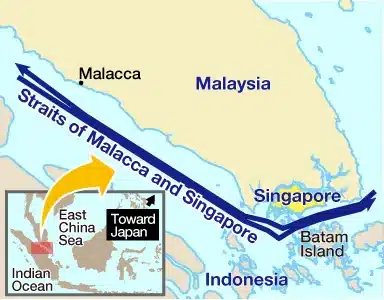China’s emergence as a global trade powerhouse has led to an increased dependence on maritime trade routes to secure energy resources and maintain its supply chains. Among these routes, the Malacca Strait holds a pivotal position. It connects the Indian Ocean to the South China Sea and serves as a critical artery for global trade. However, China’s reliance on this narrow passage has given rise to what is known as the “Malacca Dilemma,” a complex geopolitical challenge that demands careful navigation.
The Malacca Dilemma Explained
The “Malacca Dilemma” refers to China’s vulnerability stemming from its dependence on the Malacca Strait for the vast majority of its oil imports and other crucial maritime trade. Approximately 80% of China’s oil imports are transported through this narrow waterway. It is a vital lifeline for the country’s energy security. The dilemma arises from the potential threat of disruption or blockage of this crucial passage, either due to geopolitical tensions, piracy, or other unforeseen events.
Who controls the Strait of Malacca?
The Strait of Malacca, nestled between peninsular Malaysia and the Indonesian island of Sumatra, is one of the world’s most critical maritime passages. Stretching approximately 550 miles long and 40 to 155 miles wide, it connects the Indian Ocean to the Pacific Ocean. The Strait’s average depth is 25 meters.
The Strait of Malacca is an international waterway situated between Malaysia and Indonesia. It is not controlled by any single country, but it is governed by international maritime law (UNCLOS) and various navigation regulations to ensure safe passage for all vessels. However, the littoral states, Malaysia and Indonesia, have a significant role in overseeing the strait’s security and enforcing regulations.

Geopolitical Implications of the Malacca Dilemma
China’s reliance on the Malacca Strait has significant geopolitical implications. Any disruption could have far-reaching consequences for its economy and military capabilities. An effective blockade or closure of the strait could lead to a severe energy shortage. That will hamper industrial production and economic growth of the country. Additionally, it could restrict the movement of Chinese naval vessels, limiting Beijing’s ability to protect its interests in the region.
To mitigate these risks, China has been working on multiple fronts to address its Malacca Dilemma and enhance its maritime security.
Diversification of Energy Routes
China has actively pursued alternative routes for its energy imports. It has been constructing pipelines and energy corridors that bypass the Malacca dilemma. The China-Myanmar oil and gas pipelines and the China-Pakistan Economic Corridor are examples of these efforts.
String of Pearls Strategy
China has invested in port infrastructure and naval facilities in strategically located countries around the Indian Ocean, often referred to as the “String of Pearls.” These facilities provide China with potential naval bases and logistical support, reducing its dependence on a single maritime chokepoint. Pakistan’s Gwadar, Sri Lanka’s Hambantota, and Myanmar’s Sittwe are some Chinese pearls in the Indian Ocean region.
China has been rapidly modernizing its navy to enhance its capabilities for long-range operations. This includes the construction of aircraft carriers and other advanced vessels that can help protect its maritime interests further afield.
Diplomacy and Regional Cooperation
China has engaged in diplomatic efforts to strengthen ties with countries in the region, including the members of (ASEAN). By fostering economic and political cooperation, China aims to reduce the potential for conflict and ensure the stability of its maritime trade routes.
Thai Canal Project
The Thai Canal, or Kra Canal, proposes a strategic waterway cutting through southern Thailand’s Kra Isthmus. It will connect the Gulf of Thailand to the Andaman Sea. It aims to alleviate congestion and hazards in the Malacca Strait, shortening trade routes. While potentially reducing transit distances by 1,200 kilometers, concerns linger over costs, environmental impact, and geopolitical implications. China’s interest in the canal project aligns with its 21st Century Maritime Silk Road initiative. In 2015, China referred to this project as a part of the Maritime Silk Road. Earlier, a report leaked to the Washington Times in 2004 revealed that China had offered to cover the cost of the project. Despite ups and downs in prioritization, a committee was set up in 2020 to study the project’s feasibility.
Summary of China’s Malacca Dilemma
In conclusion, China’s Malacca Dilemma is a complex challenge. It highlights the interconnectedness of global trade and geopolitics. As China continues to grow as a major economic and military power, its dependence on the Malacca Strait for energy imports and trade remains a critical vulnerability. Through strategic diversification, infrastructure development, naval modernization, and diplomatic efforts, China is working to mitigate the risks associated with its reliance on this vital maritime passage. The resolution of the Malacca Dilemma will not only shape China’s future trajectory but also have broader implications for regional and global stability.







